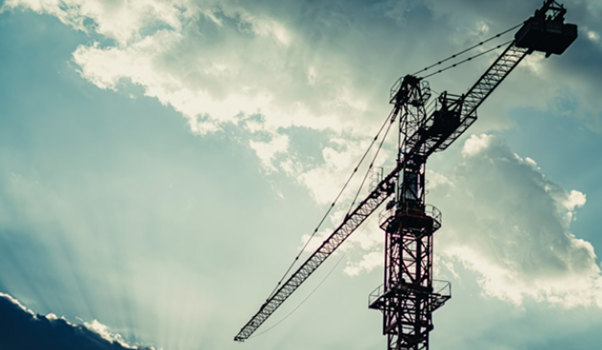
With the boom in building developments in recent years, especially the explosion of high-rise buildings, there has been the growing need for tower cranes. The use of such cranes, while efficient for contractors, often impact adjoining land which can lead to disputes if not promptly addressed.
This three-part article series will explore the:
- rights and obligations of all parties in respect of crane overhang and ground anchors extending beyond the boundary;
- necessary considerations to be made by both parties when entering into a crane overhang or ground anchor deed; and
- process for obtaining a court order in the event the parties cannot reach an agreement.
What’s the problem
Tower cranes are typically erected on the land being developed and have a long jib or boom which, when angled out from the cabin of the crane, is used to lift and deliver materials to higher levels. Tower cranes also have a counterweight which extend horizontally to balance the boom, known as a ground anchor.
Naturally, the operation of tower cranes means that at times, the boom or counterweight may need extend over the adjoining land due to the physical title boundaries of the developed property. There are some instances where the crane may be programmed so as to not traverse the boundary, however this is not always a practical outcome or efficient. Consequently, instances may arise where crane oversailing, or overhang, is an unavoidable consequence of crane usage. In a similar vein, the ground anchor of the crane (due to boundary constraints) may need to be located over or on neighbouring land.
This projection of the boom or ground anchor over the boundary line of an adjoining property gives rise to legal issues and practical problems for developers, builders and adjoining owners.
Why is it a problem
One of the most fundamental recognitions in property law is that landowners are entitled to enjoy exclusive dominion over their land. Any physical transgression onto, over or under someone else’s land without permission, constitutes trespass. Such trespass extends below the surface of the ground and to the airspace above, to the extent it is reasonably necessary for the proper enjoyment of the land.
Subject to regulatory controls, an owner has the right to erect structures to any height and for any purpose on their own land. However, there is no legal entitlement to construct structures overhanging or passing over the top of a neighbouring property. It is well established at common law that crane oversailing constitutes trespass. Consequently, where contractors are required to employ the tower cranes which will involve extending over the boundary of a neighbouring property, it must first obtain approval from the adjoining landowner. Usually, this is achieved by way of a deed between the respective landowners. Next week, we will explore crane overhang and ground anchor deeds in greater depth, specifically what both parties should consider before entering such agreement.
What happens if you can’t agree
If the two parties cannot reach an agreement, the contractor can make an application to the court for an order under s 180 of the Property Law Act 1974 (PLA) for the imposition of statutory rights of user in respect of the adjoining land.
Section 180(1) of the PLA, allows the court to impose a right of use over a piece of land where the landowner has failed to give consent. To make such an order, the court must be satisfied that:
- the imposition of the right of use is in the public interest;
- the owner of the land can be adequately compensated in monetary terms for any loss or disadvantage they suffer from the imposition of the obligation; and
- either:
- the owner has unreasonably refused to accept the imposition; or
- no person with the necessary capacity to grant a right of use can be located.
Where the court is satisfied of the above, the order made pursuant to s180(1) may take the form of an easement or licence, and will specify that such rights are exercisable:
- by such persons, their servants and agents, in such a manner and subject to such conditions; and
- on 1 or more occasions; or
- until a certain date; or
- in perpetuity or for some fixed period.
What if the builder acts without approval
If a builder erects a crane without permission, the landowner can obtain an injunction to prevent further trespass. Consequently, contractors should carefully assess whether their cranes will need to oversail neighbouring land during the design and planning stages of the project. If so, contractors ought to take the appropriate steps to gain access to adjoining land through the appropriate mechanisms. Over the next two weeks, we will explore two such mechanisms to secure the requisite rights: by way of a deed, or court order pursuant to section 180(1) of the PLA.
Lamont Project & Construction Lawyers
The Lamont Project & Construction Lawyers team has extensive knowledge regarding the process for obtaining approval for accessing air or ground rights for land neighbouring a development site. With this knowledge and expertise, Lamont Project & Construction Lawyers can provide the required support and advise on projects with respect to disputes arising from tower crane usage.
If you would like to discuss any matters raised in this article as it relates to your specific circumstances, please contact Lamont Project & Construction Lawyers.
The content of this article is for information purposes only and does not discuss every important topic or matter of law, and it is not to be relied upon as legal advice. Specialist advice should be sought regarding your specific circumstances.
Contact: Peter Lamont or Kathryn Easton
Email: peter@lpclawyers.com or kathryn@lpclawyers.com
Phone: (07) 3248 8500
Address: Suite 2, Level 2, 349 Coronation Drive, Milton Qld 4064
Postal Address: PO Box 1133, Milton Qld 4064
